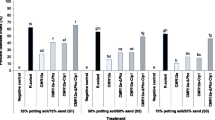Abstract.
Two strains of Pseudomonas MRS23 and CRP55b showed antagonistic activity towards the pathogenic fungi Aspergillus sp., Fusarium oxysporum f. sp. ciceri, Pythium aphanidermatum and Rhizoctonia solani under culture conditions. Larger growth inhibition zones were obtained on nutrient agar (NA) and King's B media in comparison to potato dextrose agar and pigment production media. Both the strains produced siderophore in agar plates as well as in liquid cultures. Fungal inhibition zones were reduced in size and abolished in iron-supplemented NA medium by Pseudomonas strains MRS23 and CRP55b, respectively, indicating that some other metabolites along with siderophores are involved in growth inhibition of fungi by strain MRS23, whereas CRP55b produced only siderophores. Only Pseudomonas strain MRS23 was found to produce hydrocyanic acid (HCN). Seed bacterization with Pseudomonas strains of two chickpea (Cicer arietinum L.) cultivars, H8618 and C235, showed root-stunting effects at 5 days, whereas this inhibitory effect was overcome at 10 days of seedling growth in cv. H8618. Coinoculation of chickpea with Pseudomonas strains MRS23 and CRP55b, and Mesorhizobium sp. Cicer strain Ca181 resulted in the formation of 68.2–115.4% more nodules at 80 and 100 days after planting as compared to single inoculation with the Mesorhizobium strain under sterile conditions. The shoot dry weight ratios of coinoculated treatments at different stages of plant growth varied from 1.18 to 1.35 times that of Mesorhizobium-inoculated and 3.25 to 4.06 times those in uninoculated controls. The plant N contents were also increased significantly on coinoculation. Coinoculation effects of HCN-producing strain MRS23 were significantly lower than those of non-HCN-producing strain CRP55b in terms of shoot dry weight and shoot N. The results demonstrated the potential benefits of using rhizosphere bacteria as coinocula in nodule promotion and plant growth in chickpea.
Similar content being viewed by others
Author information
Authors and Affiliations
Additional information
Electronic Publication
Rights and permissions
About this article
Cite this article
Goel, .A., Sindhu, .S. & Dadarwal, .K. Stimulation of nodulation and plant growth of chickpea (Cicer arietinum L.) by Pseudomonas spp. antagonistic to fungal pathogens. Biol Fertil Soils 36, 391–396 (2002). https://doi.org/10.1007/s00374-002-0554-5
Received:
Accepted:
Issue Date:
DOI: https://doi.org/10.1007/s00374-002-0554-5




